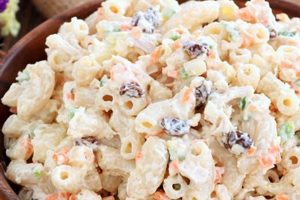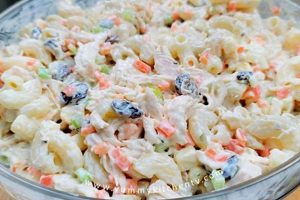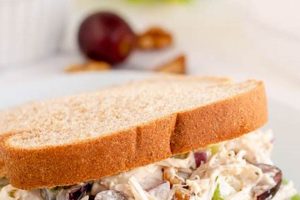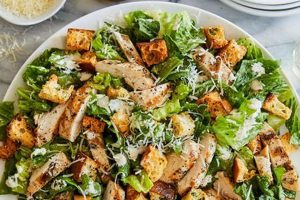A dish composed of cooked chicken, cranberries, and almonds, often combined with mayonnaise and other seasonings, constitutes a popular and versatile salad. Variations may include celery, onion, grapes, or walnuts, offering a spectrum of flavors and textures. This blend of sweet, tart, savory, and crunchy elements creates a balanced and refreshing culinary experience.
The combination of lean protein from the chicken, antioxidants from the cranberries, and healthy fats from the almonds offers a nutritionally sound meal option. Historically, chicken salad has evolved from simpler preparations, with the addition of fruits and nuts reflecting a trend toward more complex flavor profiles and increased nutritional value. This particular combination offers a festive and appealing option suitable for picnics, potlucks, or light lunches, and can be served on bread, crackers, lettuce cups, or as a standalone dish.
Further exploration will delve into specific ingredient selections, preparation methods, and serving suggestions, providing a comprehensive guide to creating and enjoying this delightful salad. Nutritional information and variations catering to specific dietary needs will also be addressed.
Tips for a Superior Chicken Salad Experience
Elevating a simple chicken salad to a culinary masterpiece involves careful consideration of ingredients and techniques. The following tips provide guidance for achieving optimal flavor and texture.
Tip 1: Chicken Selection: Opt for high-quality, cooked chicken breast. Roasting or poaching yields superior flavor compared to pre-cooked or canned options. Ensure the chicken is cooled completely before shredding or dicing to prevent a mushy texture.
Tip 2: Cranberry Choice: Dried cranberries provide sweetness and chewiness. Consider using Craisins or other high-quality dried cranberries for optimal plumpness and flavor. Fresh cranberries can also be incorporated, but require pre-cooking and sweetening.
Tip 3: Almond Preparation: Toasting almonds enhances their flavor and provides a satisfying crunch. Slivered, sliced, or chopped almonds work well, but ensure they are toasted lightly to avoid bitterness.
Tip 4: Mayonnaise Matters: Use a good quality mayonnaise as the base. Full-fat mayonnaise provides a richer flavor, but low-fat or Greek yogurt alternatives can be substituted for a lighter version.
Tip 5: Flavor Enhancement: Fresh herbs, such as dill, chives, or tarragon, can elevate the flavor profile. A touch of Dijon mustard or lemon juice can also add brightness and complexity.
Tip 6: Texture Optimization: Incorporating finely diced celery or red onion adds a pleasant crunch and textural contrast. Chopped walnuts or pecans can be used in addition to or as a substitute for almonds.
Tip 7: Chill Time: Allowing the salad to chill for at least 30 minutes before serving allows the flavors to meld and enhances the overall experience.
By implementing these suggestions, one can create a chicken salad that is both flavorful and texturally appealing, transforming a simple dish into a memorable culinary creation.
These tips offer a foundation for crafting a delectable chicken salad. Experimentation with different ingredients and flavor combinations can further personalize this versatile dish.
1. Chicken (cooked, diced)
Cooked, diced chicken forms the foundational protein base of a cranberry chicken salad. Its preparation and characteristics significantly influence the overall texture and flavor profile of the final dish. Understanding these nuances allows for a more informed approach to creating a well-balanced and enjoyable salad.
- Cooking Method Influence
The method employed for cooking the chicken impacts its flavor and texture contribution to the salad. Roasting or grilling imparts smoky notes and a firmer texture, while poaching results in a milder flavor and more tender consistency. Each method offers a distinct character, influencing the overall salad experience. Boiling, while efficient, can sometimes result in a drier, less flavorful outcome compared to other methods.
- Dice Size Considerations
The size of the chicken dice affects both the texture and visual appeal of the salad. Larger pieces provide a more substantial bite, while smaller pieces offer a smoother, more cohesive blend. The chosen dice size should complement the other ingredients, such as cranberries and almonds, ensuring a harmonious balance of textures. A uniform dice size also contributes to a more aesthetically pleasing presentation.
- Chicken Type and Quality
While chicken breast is the most common choice for its lean protein and neutral flavor, other cuts, such as thigh meat, can be utilized for a richer, more flavorful salad. The quality of the chicken itself also plays a crucial role; free-range or organic chicken often contributes a superior flavor and texture compared to conventionally raised poultry.
- Seasoning and Marinades
Pre-seasoning or marinating the chicken before cooking can further enhance its flavor contribution to the salad. Simple seasonings like salt, pepper, and garlic powder work well, while more complex marinades incorporating herbs, spices, or citrus can add depth and complexity. This pre-emptive flavoring complements the other salad components, creating a more nuanced and satisfying final product.
The interplay between these factorscooking method, dice size, chicken type, and seasoningultimately determines the chicken’s role within the cranberry, almond, and chicken salad composition. Thoughtful consideration of these elements allows for a more tailored and ultimately more enjoyable culinary experience. For instance, a salad featuring grilled, coarsely diced chicken offers a heartier, more robust experience, while a salad composed of poached, finely diced chicken presents a lighter, more delicate profile. The choice depends on individual preferences and the desired overall character of the salad.
2. Cranberries (dried, sweet)
Dried cranberries contribute a crucial dimension of sweetness and tartness to cranberry chicken salad, complementing the savory chicken and crunchy almonds. Their distinct characteristics significantly influence the overall flavor profile and textural complexity of the dish. Understanding the nuances of cranberry selection and usage is essential for crafting a well-balanced and enjoyable salad.
- Sweetness and Tartness Balance
The balance between sweetness and tartness in dried cranberries plays a crucial role in the overall flavor profile of the salad. Cranberries with a higher sugar content contribute a more pronounced sweetness, while those with lower sugar content offer a more tart flavor. This balance interacts with the other ingredients, particularly the savory chicken and mayonnaise, to create a complex and balanced flavor experience. The desired level of sweetness can be adjusted based on personal preference and the overall composition of the salad.
- Moisture Content and Texture
The moisture content of dried cranberries affects both the texture of the individual cranberries and the overall consistency of the salad. Plumper, moister cranberries contribute a softer, chewier texture, while drier cranberries offer a firmer, more concentrated burst of flavor. This textural element interacts with the other ingredients, adding depth and complexity to each bite. Excessively dry cranberries can become tough, while overly moist cranberries may release excess moisture into the salad, potentially affecting its overall consistency.
- Cranberry Quality and Sourcing
The quality and sourcing of dried cranberries can significantly impact their flavor and overall contribution to the salad. Higher-quality cranberries are typically plumper, more flavorful, and less likely to contain added sugars or preservatives. Sourcing cranberries from reputable suppliers ensures a consistent and desirable flavor profile. Organic or naturally sweetened cranberries offer a healthier alternative without compromising on taste.
- Cranberry Preparation and Incorporation
While dried cranberries are typically added directly to the salad, certain preparations can further enhance their flavor and texture contribution. Briefly soaking the cranberries in warm water or juice can plump them up and intensify their flavor. Chopping larger cranberries into smaller pieces can create a more even distribution of flavor and texture throughout the salad. These seemingly minor adjustments can significantly impact the overall culinary experience.
The careful consideration of sweetness, moisture content, quality, and preparation techniques ensures that the dried cranberries contribute optimally to the overall harmony of the cranberry chicken salad. These nuances, combined with the other ingredientschicken, almonds, and mayonnaisecreate a balanced and flavorful dish where each component complements the others. The specific characteristics of the chosen cranberries will influence the final taste and texture, offering a range of possibilities from a brightly tart and chewy salad to a sweeter, more delicate rendition.
3. Almonds (toasted, slivered)
Almonds, specifically toasted and slivered, provide a critical textural and flavor component within cranberry chicken salad. Their presence introduces a contrasting crunch against the softer chicken and cranberries, while their distinct nutty flavor complements the sweet-tart profile of the fruit. Understanding the nuances of almond selection, preparation, and contribution within this specific recipe context is crucial for optimizing the overall sensory experience.
- Toasting’s Impact on Flavor and Texture
Toasting almonds intensifies their inherent nutty flavor and creates a desirable crisp texture. The application of heat releases aromatic compounds, deepening the flavor profile from mild and buttery to rich and complex. This enhanced flavor profile interacts synergistically with the other ingredients, particularly the sweetness of the cranberries and the savory notes of the chicken. Furthermore, the toasting process reduces moisture content, amplifying the crunchy texture that contrasts with the softer elements of the salad. The degree of toasting influences both flavor and texture; lighter toasting preserves a delicate flavor and subtle crunch, while darker toasting yields a more intense, almost smoky flavor and a pronounced crispness.
- Slivered Form and Textural Contribution
The slivered form of the almonds contributes significantly to the textural complexity of the salad. Slivers offer a delicate crunch that integrates seamlessly with the other ingredients, avoiding an overwhelming or disruptive textural presence. This form also facilitates even distribution throughout the salad, ensuring a consistent textural experience in each bite. Compared to whole or chopped almonds, slivers provide a more refined and balanced textural contrast, harmonizing with the diced chicken and dried cranberries.
- Nutritional Value and Health Benefits
Beyond their flavor and texture contributions, almonds offer notable nutritional value. They are a good source of healthy fats, fiber, protein, and vitamin E, adding a nutritious element to the salad. These nutrients complement the lean protein from the chicken and the antioxidants present in cranberries, contributing to a more wholesome and balanced meal. The inclusion of almonds elevates the salad beyond a simple combination of ingredients to a dish that offers both culinary satisfaction and nutritional benefits.
- Almond Alternatives and Substitutions
While almonds are the traditional choice in this recipe, other nuts or seeds can be substituted to create variations or accommodate dietary restrictions. Walnuts, pecans, or sunflower seeds offer alternative flavor profiles and textures, allowing for customization and exploration. However, it’s crucial to consider how these substitutions might impact the overall flavor balance and textural harmony of the salad. For example, walnuts offer a more robust, earthy flavor compared to almonds, while sunflower seeds provide a different type of crunch and a milder flavor profile.
The interplay between the toasting process, the slivered form, the nutritional benefits, and the potential for substitutions underscores the significant role almonds play in cranberry chicken salad. Their contribution extends beyond mere texture and flavor, enhancing both the nutritional value and the overall culinary experience. Careful consideration of these factors ensures that the almonds integrate seamlessly with the other components, creating a cohesive and satisfying dish where each ingredient complements the others harmoniously.
4. Mayonnaise (binder, flavor)
Mayonnaise performs a dual role in cranberry chicken salad with almonds, functioning as both a binding agent and a flavor component. Its presence contributes significantly to the texture, consistency, and overall palate experience. Understanding its multifaceted role is essential for crafting a well-balanced and enjoyable salad.
- Emulsification and Binding
Mayonnaise, an emulsion of oil and egg yolks, acts as the primary binding agent, holding the diverse ingredientschicken, cranberries, almondstogether in a cohesive mixture. This emulsification creates a creamy matrix that coats the individual components, preventing the salad from becoming dry or crumbly. The viscosity of the mayonnaise influences how the ingredients cling together and how the salad holds its shape. A thicker mayonnaise yields a firmer salad, while a thinner mayonnaise results in a looser consistency.
- Flavor Enhancement and Balance
Beyond its structural role, mayonnaise contributes a rich, tangy flavor derived from the oil, egg yolks, and vinegar or lemon juice used in its preparation. This tanginess complements the sweetness of the cranberries and provides a counterpoint to the savory chicken and nutty almonds. The specific flavor profile of the mayonnaise, whether classic, Dijon-infused, or otherwise flavored, can subtly alter the overall taste of the salad. Choosing a mayonnaise with complementary flavors enhances the complexity and balance of the final dish.
- Texture and Mouthfeel
The creamy texture of mayonnaise contributes significantly to the mouthfeel of the salad, providing a smooth, luscious contrast to the crunch of the almonds and the chewiness of the cranberries. The amount of mayonnaise used directly impacts the salads overall consistency and texture, ranging from a light and fluffy texture with less mayonnaise to a richer, creamier texture with more. Finding the optimal balance ensures a pleasant and satisfying sensory experience.
- Alternatives and Substitutions
While traditional mayonnaise remains a popular choice, alternatives like Greek yogurt, plain yogurt, or avocado-based spreads offer variations in flavor, fat content, and overall nutritional profile. These substitutions can cater to dietary restrictions or preferences, offering a lighter or tangier alternative to traditional mayonnaise. However, substitutions can impact the final flavor and texture, requiring adjustments to other ingredients or seasonings to maintain a balanced and enjoyable salad.
The interplay between mayonnaise’s binding properties, flavor contribution, textural influence, and potential substitutions underscores its pivotal role in cranberry chicken salad with almonds. Careful consideration of these factorsfrom the type of mayonnaise used to the quantity incorporatedallows for a tailored culinary outcome, balancing flavor, texture, and overall enjoyment. The choice of mayonnaise, or its substitute, should complement the other ingredients, contributing to a harmonious and satisfying culinary creation.
5. Seasoning (salt, pepper)
Seasoning, primarily salt and pepper, plays a crucial, albeit often understated, role in cranberry chicken salad with almonds. While other ingredients provide the dominant flavors and textures, proper seasoning elevates the dish by enhancing the existing flavors and creating a balanced palate experience. Understanding the nuances of seasoning allows for a more refined and flavorful outcome.
- Balancing Flavors
Salt and pepper are not merely flavor additions; they function as flavor enhancers. Salt amplifies the inherent sweetness of the cranberries and the savory notes of the chicken, while pepper adds a subtle layer of complexity and depth. The interplay between these seasonings creates a balanced flavor profile, preventing any single ingredient from dominating the palate. Proper seasoning ensures that the sweetness, savoriness, and nuttiness of the ingredients harmonize rather than compete.
- Enhancing Existing Ingredients
The judicious use of salt and pepper draws out the nuanced flavors of the other ingredients. Salt, in particular, has the ability to unlock hidden flavors, making the sweetness of the cranberries more pronounced and the savoriness of the chicken more intense. Pepper adds a subtle warmth and complexity, complementing the nutty notes of the almonds. This synergistic effect elevates the overall flavor profile of the salad beyond a simple sum of its parts.
- Textural Perception
While not directly impacting texture, seasoning indirectly influences textural perception. By enhancing flavors, salt and pepper create a more engaging sensory experience, making the crunch of the almonds and the chewiness of the cranberries more pronounced. This heightened awareness of texture contributes to a more satisfying and dynamic culinary experience.
- Seasoning Beyond Salt and Pepper
While salt and pepper form the foundation of seasoning, other complementary spices and herbs can further enhance the flavor profile of the cranberry chicken salad. A pinch of onion powder or garlic powder can add subtle savory notes, while a touch of dried herbs like thyme or rosemary can introduce earthy complexity. These additions should be used judiciously to avoid overpowering the core flavors of the salad. Experimentation with different seasonings allows for customization and the creation of unique flavor profiles tailored to individual preferences.
The seemingly simple act of seasoning with salt and pepper, along with the potential for nuanced additions, significantly impacts the overall enjoyment of cranberry chicken salad with almonds. The careful balance of these seasonings elevates the dish from a simple combination of ingredients to a cohesive and flavorful culinary experience. Attention to seasoning demonstrates a nuanced understanding of flavor development and a commitment to crafting a truly exceptional salad.
6. Optional additions (celery, onion)
Optional additions, such as celery and onion, offer opportunities to further enhance the flavor and textural complexity of cranberry chicken salad with almonds. While not essential to the core recipe, these additions contribute distinct characteristics that can elevate the overall sensory experience. Understanding their individual contributions and their impact on the final product allows for informed customization and a more nuanced culinary outcome.
- Celery: Textural Contrast and Freshness
Celery contributes a crisp, refreshing counterpoint to the creamy mayonnaise and softer ingredients. Its subtle, slightly vegetal flavor complements the sweetness of the cranberries and the savoriness of the chicken without overpowering the other components. Finely diced celery provides a delicate crunch, while larger pieces offer a more substantial bite. This textural contrast enhances the overall eating experience, adding a refreshing element that balances the richness of the other ingredients.
- Onion: Pungency and Flavor Depth
Onion introduces a subtle pungency and depth of flavor that complements the sweetness and nuttiness of the salad. The specific type of onionred, yellow, or whiteinfluences the intensity of flavor and the overall character of the dish. Red onion offers a milder, slightly sweet flavor, while yellow or white onions provide a more assertive pungency. Finely diced onion ensures even distribution of flavor without overwhelming the other ingredients. The onion’s sharpness balances the richness of the mayonnaise and enhances the overall flavor complexity.
- Balancing Flavors and Textures
The combined use of celery and onion introduces a balanced interplay of flavors and textures. The celery’s freshness and crunch complement the onion’s pungency, creating a dynamic interplay that enhances the overall sensory experience. This combination adds depth and complexity without overpowering the core flavors of the chicken, cranberries, and almonds. The relative proportions of celery and onion can be adjusted to achieve the desired balance of flavors and textures.
- Alternative Optional Additions
Beyond celery and onion, other optional additions can further customize the flavor profile of the salad. Chopped grapes or apples can introduce additional sweetness and textural variation, while chopped walnuts or pecans can complement the almonds. Fresh herbs, such as dill, chives, or parsley, can add brightness and complexity. These additions offer opportunities for creative exploration and personalization, allowing for a wide range of flavor combinations tailored to individual preferences.
The incorporation of optional ingredients like celery and onion, along with other potential additions, allows for a nuanced approach to crafting cranberry chicken salad with almonds. These additions, while not essential, offer opportunities to enhance flavor, texture, and overall enjoyment. Careful consideration of these optional components and their interplay with the core ingredients allows for a truly customized and satisfying culinary experience.
Frequently Asked Questions
This section addresses common inquiries regarding the preparation and enjoyment of cranberry chicken salad with almonds. Clarity on these points ensures a successful and satisfying culinary experience.
Question 1: What type of chicken is best suited for this salad?
While cooked chicken breast is frequently chosen for its lean protein and neutral flavor, using roasted or poached chicken thighs yields a richer, more flavorful result. The cooking method influences the final texture and taste.
Question 2: Can fresh cranberries be used instead of dried?
Fresh cranberries can be incorporated, but require pre-cooking with sugar to balance their tartness. This introduces a different textural element compared to the chewy dried cranberries.
Question 3: Is toasting the almonds essential?
Toasting almonds significantly enhances their flavor and provides a desirable crunch. Untoasted almonds lack the same depth of flavor and textural contrast.
Question 4: How long can this salad be stored in the refrigerator?
Properly stored in an airtight container, the salad can be refrigerated for up to three days. Beyond this timeframe, quality and safety may be compromised.
Question 5: Can this salad be frozen?
Freezing is not recommended, as the mayonnaise-based dressing can separate upon thawing, resulting in an undesirable texture. The textural integrity of the other ingredients may also be affected.
Question 6: What are some suitable serving suggestions?
This versatile salad can be served on bread, croissants, crackers, lettuce cups, or enjoyed as a standalone dish. It also pairs well with a side of fresh fruit or a green salad.
Addressing these common inquiries provides a foundation for successful preparation and enjoyment. Understanding these nuances allows for informed choices and a more satisfying culinary experience.
The following section will delve into variations and adaptations of this recipe, catering to diverse dietary needs and preferences.
Cranberry Chicken Salad Recipe Almonds
This exploration has detailed the multifaceted nature of cranberry chicken salad incorporating almonds, emphasizing the careful balance of ingredients, textures, and flavors that contribute to a successful preparation. From the selection of chicken and the nuances of cranberry and almond preparation to the role of mayonnaise and the importance of seasoning, each component contributes significantly to the final product. The potential for customization through optional additions further expands the possibilities of this versatile dish.
Culinary creations, even seemingly simple ones, offer opportunities for nuanced understanding and creative expression. The thoughtful combination of ingredients, informed by an understanding of their individual characteristics, elevates everyday meals into memorable experiences. This exploration encourages a deeper appreciation for the culinary arts and the potential for creativity within the kitchen.






